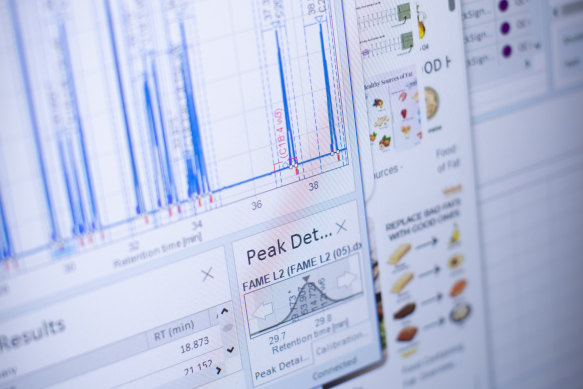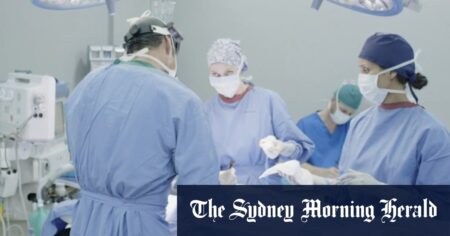“What you see on CSI [the TV show] is a load of crap,” said Stobaus. “You can’t put a sample item into a machine and get a read-out of all the different bits in there. It just doesn’t work like that; it’s actually quite complex.”
Stobaus said Australia had robust food standards. “There are markets out there with quite stringent requirements, and we have undertaken work for export programs,” he said.
But in Port Melbourne, we learn some hard truths about the nutritional panels on food that show how much salt, sugar and protein, for example, a manufactured food has.
Scientist Sam Barone in the National Measurement Institute’s analytical services branch.Credit: Simon Schluter
“Even under the very best condition of perfect sampling, perfect preparation, perfect extraction and perfect measurement, we have a concept called measurement uncertainty, which is imprecision that’s inherent in the process,” Stobaus said. “Sometimes you’ve got to think, ‘Well, OK, that packet says it’s got 5.6 grams of fat.’ Well, probably anywhere between 5.3 and 5.9.”
For food testing to be meaningful, staff start with a representative portion of the product. This is trickier than it sounds.
“You can’t just grab an apple from a tree. You’ve got to systematically take apple samples from across your orchard,” Stobaus said. What is eaten is tested, so apples’ skins are in but apple cores and bananas’ skins are out.
“Particularly with things like prawns or lobsters, if you just eat the flesh, that’s one exposure. But if you’re undertaking traditional Vietnamese or Chinese cooking, you use the whole thing, you can include parts of the animal that accumulate toxic substances, so it’s different depending on the use.”

Food testing at the institute.Credit: Simon Schluter
In the sample preparation area, staff use nitrogen to freeze the items and grind them up for testing. “Jelly lollies are really super-hard to work with, so we’ve got a range of tools for that, such as blenders,” Stobaus said.
In the chemical testing wing, scientists weigh out a portion of a sample and add a solvent to extract things such as veterinary drug residues in meat and milk. In 2020, China suspended exports from various Australian meatworks after detecting the banned chemical chloramphenicol in beef products.
“There are very strict controls over the presence of those antibiotics in the actual meat. And this is where you can easily fall foul of the international requirements,” Stobaus said.
Loading
Traceability with food is becoming a bigger issue for consumers, and it’s particularly important for Australian-origin food, especially indigenous food. “Being able to demonstrate that a product is what it purports to be, and is where it purports to be from, is a growing area of interest,” Stobaus said.
So, does working in food safety and nutritional testing make National Measurement Institute staff particular about what they eat?
“I eat way too many carbohydrates,” said Stobaus. “I’m conscious of highly saturated fat food and trans fat.
“But different types of food, different level of issue. So if a fish and chip [shop] has used the same oil again and again to cook their fish and chips, you’ll start to have a trans fat issue.”
The Examine newsletter explains and analyses science with a rigorous focus on the evidence. Sign up to get it each week.
Read the full article here

















